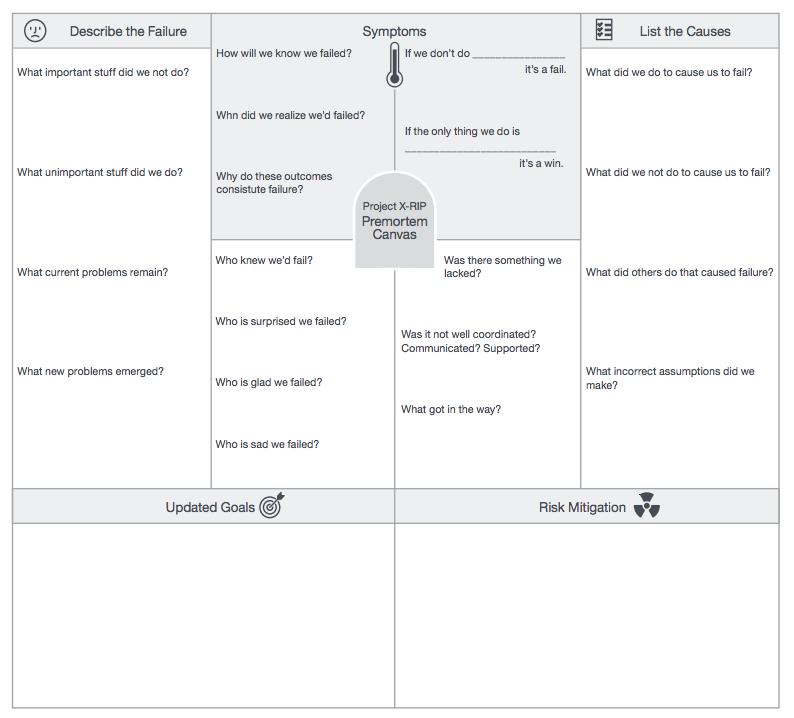Thank you for visiting the Innovation Toolkit
Develop plan
|Premortem
Frame and explore your problem by imagining a future scenario in which the proposed activity fails to achieve its objective, describing the failure, then identifying the causes of the failure. Give your team insight into priorities and success criteria, uncover hidden assumptions, and identify potential pitfalls.
Session Length: 60+ minutes Group Size: 6+ people Prep Time: 20+ minutes
WHEN
This tool is helpful at the beginning of an activity, or any time the definition of success is being determined or assessed.
WHY
This tool can help provide clarity about “what success looks like”; uncover hidden assumptions about activities, outcomes, success, and failure; and identify potential causes of failure. Premortems often accelerate discovery of the team’s actual goals, and are an excellent enabler of adaptive thinking, because this activity encourages the group to explore a wide range of scenarios. The Premortem also creates space for everyone on the team to participate, regardless of rank or background, and to take risks with sharing ideas.
HOW
Assemble the project team, and give each member a copy of the Premortem Canvas. Invite everyone to imagine it is two years in the future. Your current project, activity, or initiative has utterly failed. Spend a few minutes writing down answers to the questions in the canvas, then discuss answers with the larger group.
STEP 1:
Describe the failure. Using vivid detail, describe what it would look like if your project failed completely. Focus on outcomes and attributes, not behaviors or causes. Don’t hold back or self-edit. Use extreme language and explore the worst-case scenarios. It is important for the facilitator to adopt a curious, open posture and create a “high-trust” environment where each participant is free to share and contribute.
STEP 2:
List the causes. Assemble a list of potential causes for the failure. Consider a wide range, including action, inaction, assumptions, priorities, distractions, people, organizations, and processes. Include anything that might be a contributing factor.
STEP 3:
Update goals and risks. Compare the failure description with the team’s current definition of success (goals, objectives, etc.) and the team’s current action plans. Discuss whether accomplishing the team’s goals and activities would prevent the future failure scenarios. Adjust goal statements as needed.
STEP 4:
Examine the list of causes and identify the most likely failure drivers. Discuss which causes are avoidable and whether the team is taking appropriate steps to mitigate or prevent them from occurring.
Want to read about how NASA used this tool? Check out this blog post!
Premortem |Worksheet

Download this tool to print out and start using with your team. Each download includes a tool description and if applicable, a template and example.

